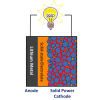Climate & Environment
- <p>A pair of breakthroughs in the field of silicon photonics by researchers at the University of Colorado Boulder, the Massachusetts Institute of Technology and Micron Technology Inc. could allow for the trajectory of exponential improvement in microprocessors that began nearly half a century ago—known as Moore’s Law—to continue well into the future, allowing for increasingly faster electronics, from supercomputers to laptops to smartphones.</p>
- <p>A University of Colorado Boulder professor has been awarded a three-year, $3.6 million grant from the Energy Department’s Advanced Research Projects Agency to develop a new process to produce magnesium that can be used to make lightweight vehicle parts.</p>
 <p>A cutting-edge battery technology developed at the University of Colorado Boulder that could allow tomorrow’s electric vehicles to travel twice as far on a charge is now closer to becoming a commercial reality.</p>
<p>A cutting-edge battery technology developed at the University of Colorado Boulder that could allow tomorrow’s electric vehicles to travel twice as far on a charge is now closer to becoming a commercial reality.</p>
<p>CU’s Technology Transfer Office has completed an agreement with Solid Power LLC—a CU-Boulder spinoff company founded by Se-Hee Lee and Conrad Stoldt, both associate professors of mechanical engineering—for the development and commercialization of an innovative solid-state rechargeable battery. </p>- <p>The University of Colorado Boulder has launched a flood resource website and is hosting a resource table to help students, faculty and staff who are still dealing with effects from the flood.</p>
- <p>Scientists have uncovered strong evidence that soot, or black carbon, sent into the air by a rapidly industrializing Europe, likely caused the abrupt retreat of mountain glaciers in the European Alps.</p>
- <div id="top-wrapper">
<div id="top">
<p>DOE news release</p>
<p>Washington, D.C. – The U.S. Department of Energy today announced the members of the Secretary of Energy Advisory Board (SEAB). The nineteen member board comprised of scientists, business executives, academics and former government officials will serve as an independent advisory committee to Energy Secretary Moniz.</p></div></div> - <p><span>The spacecraft for NASA’s Atmosphere and Volatile EvolutioN, or MAVEN, mission to Mars being led by the University of Colorado Boulder has arrived in Florida in anticipation of a November launch.</span></p>
<p>The spacecraft was shipped on Friday, Aug. 2, aboard a U.S. Air Force cargo plane from Buckley Air Force Base in Aurora, Colo., to the Shuttle Landing Facility at NASA’s Kennedy Space Center on Merritt Island, Fla. Lockheed Martin had previously assembled and tested MAVEN in its Littleton, Colo., facility.</p> - <p><span>A University of Colorado Boulder team has developed a radically new technique that uses the power of sunlight to efficiently split water into its components of hydrogen and oxygen, paving the way for the broad use of hydrogen as a clean, green fuel.</span></p>
- <p>Year-round ice-free conditions across the surface of the Arctic Ocean could explain why the Earth was substantially warmer during the Pliocene Epoch than it is today, despite similar concentrations of carbon dioxide in the atmosphere, according to new research carried out at the University of Colorado Boulder.</p>
<p>In early May, instruments at the Mauna Loa Observatory in Hawaii marked a new record: The concentration of carbon dioxide climbed to 400 parts per million for the first time in modern history. </p>  <p>Pieter Johnson, assistant professor of ecology and evolutionary biology at CU-Boulder, is having a pretty good year. He and a co-researcher have won an award recognizing outstanding contributions to ecology, and he has been named an Early Career Fellow by the Ecological Society of America.</p>
<p>Pieter Johnson, assistant professor of ecology and evolutionary biology at CU-Boulder, is having a pretty good year. He and a co-researcher have won an award recognizing outstanding contributions to ecology, and he has been named an Early Career Fellow by the Ecological Society of America.</p>


